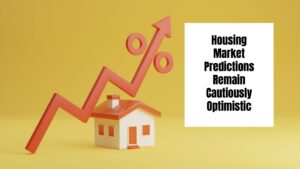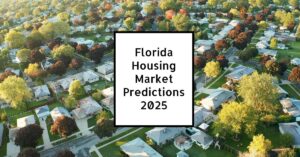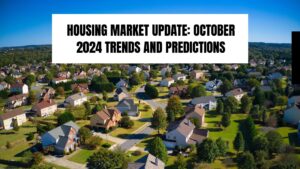Housing Market Outlook – October 2024
Key Takeaways:
- Economic Resilience: According to Freddie Mac, the U.S. economy has demonstrated strength, with a revised GDP growth rate of 3% for Q2 2024.
- Mortgage Rate Decline: A drop in mortgage rates has reached a two-year low, helping rejuvenate the housing market.
- Rise of First-Time Homebuyers: First-time buyers are increasingly influencing market dynamics despite rising challenges regarding affordability.
- Supply Shortage: The housing inventory continues to be tight, constraining the overall market expansion potential.
- Robust Job Growth: Over 1.8 million jobs were added in 2024, significantly supporting consumer purchasing power.
State of the U.S. Economy
The U.S. economy stands strong as we move into the last quarter of 2024. According to the latest data from the Bureau of Economic Analysis (BEA), the real Gross Domestic Product (GDP) grew by 3% in the second quarter—a number consistent with prior estimates.
This growth trajectory is largely attributed to consumer spending, which saw an impressive increase of 2.8%, along with robust private inventory investments. Furthermore, job growth paints an optimistic picture; the Bureau of Labor Statistics (BLS) reported that 254,000 payroll jobs were added in September alone, making for a total of 1.8 million jobs added in the first nine months of 2024.
With these figures, the unemployment rate edged down to 4.1%, indicating an overall tight labor market where wage growth remains steady at an annual rate of 4%. Notably, job openings increased from 7.7 million in July to 8 million in August, suggesting that employers are still actively seeking talent. This combination of economic and employment growth bolsters consumer confidence, further driving demand in various sectors, including housing.
Current Housing Market Dynamics
Despite an improving economy, the housing market is experiencing a unique mix of challenges and opportunities. For starters, even as total home sales (including new and existing homes) dipped by 2.9% in August, a noteworthy decline in mortgage rates to around 6.08% has begun to breathe some life back into the market.
After hitting a historic low, the pending home sales index rose slightly, indicating potential recovery and renewed interest from buyers. However, the recent spike in mortgage rates due to a positive jobs report raises concerns about future affordability, painting a mixed picture for prospective buyers. Supply constraints remain stark; existing homes on the market provided just 4.2 months’ worth of inventory, compared to the need for at least six months’ worth for a balanced market.
As a result, while many buyers are eager to purchase their first homes, the continuing inventory issues prevent the market from fully capitalizing on favorable economic conditions.
The Rise of First-Time Homebuyers
One of the critical trends shaping the current housing market is the growing influence of first-time homebuyers. This demographic is becoming increasingly crucial, not only as new entrants into the market but also as a determining factor in housing demand moving forward. With Millennials now transitioning into prime home-buying age and Gen Z starting to enter the workforce, the potential for first-time buyers is significant.
Data from Freddie Mac indicates a leap in the share of first-time homebuyers in the market, now accounting for over 50% of funded loans, a considerable increase from about 45% in previous years. This shift can be attributed to two main developments: favorable economic conditions that have improved disposable incomes and ongoing constraints hindering repeat buyers, particularly because they are less inclined to sell amidst stable mortgage rates.
While the emergence of first-time buyers bodes well for the market, it is crucial to recognize that this group faces unique hurdles, especially regarding affordability and supply.
Challenges for First-Time Buyers
Navigating the housing market as a first-time buyer comes with its own set of challenges:
- Affordability: While mortgage rates have been declining, housing prices remain steep. Since 2000, entry-level homes have seen price growth happen at a rate 63% higher than that of high-end homes. Many first-time buyers are finding it increasingly difficult to enter the market with median home prices often outpacing wage growth and inflation adjustments.
- Supply Constraints: Even as demand increases from new buyers, the lack of available homes continues to put pressure on the market. The rising number of renters competing for the same limited housing supply has escalated the number of renters per available home to above 30, marking a significant increase since 2006. As long as this supply-demand imbalance persists, affordability challenges will intensify, leaving many first-time buyers in a tough position.
- Economic Conditions: The tight monetary policy from the Federal Reserve, while aimed at controlling inflation, has introduced pressures that could inadvertently affect consumer confidence and purchasing power. Increasing unemployment among renters, which has risen from 5% to over 6% since 2023, exacerbates concerns that economic disjunctions may directly impact future first-time homebuyer activity. Many future buyers are currently renters, and job security is a foundation for their ability to transition into homeownership.
The Future Outlook for the Housing Market
Looking forward, market experts predict that the Housing Market Outlook remains cautiously optimistic but acknowledges the complexity that lies ahead. Although economic indicators indicate growth, potential volatility is still a factor driven by fluctuating mortgage rates and ongoing inventory issues.
The Federal Reserve’s decision to reduce the federal funds rate by 0.5 percentage points in September may provide an additional boost to the housing market, however, robust price pressures and constrained supply will likely temper the extent of any gains. Further easing of mortgage rates is expected, with additional cuts of nearly one percentage point anticipated through 2025, but the immediate effects may be softened by existing factors such as the continued lock-in effect—where existing homeowners are reluctant to sell to new purchasers due to low existing mortgage rates.
Expectations for home prices suggest a continued upward trajectory. Illustrated by the FHFA House Price Index, prices saw 4.5% growth over the past year, and that trend looks set to persist amid significant demand and limited supply, leading to a further increase in prices.
My Opinion
Reflecting on the Housing Market Outlook for October 2024, it is evident that while declining mortgage rates present new avenues for purchasing, the supply challenges coupled with rising prices may continue to frustrate many first-time buyers. Solutions that address these hurdles are essential for ensuring the housing market remains accessible for those eager to take their first step into homeownership.
Conclusion: An Economic and Housing Market Interconnected Landscape
In summary, the Housing Market Outlook for October 2024 presents a dual narrative of economic jubilance paired with a nuanced housing market fraught with challenges. The rise of first-time homebuyers and the potential for ongoing economic growth offer hope, yet their journeys into homeownership will be contingent upon addressing critical issues related to affordability and inventory. The road ahead for homebuyers remains complex, but with more attention to easing economic pressures and confronting supply shortages, there lies potential for increased housing accessibility in the coming years.
Also Read:
- Housing Market Predictions for Next Year: Prices to Rise by 4.4%
- Housing Market Predictions for the Next 4 Years: 2024 to 2028
- Real Estate Forecast Next 5 Years: Top 5 Predictions for Future
- Real Estate Market Predictions 2025: What to Expect
- Is the Housing Market on the Brink in 2024: Crash or Boom?
- 2008 Forecaster Warns: Housing Market 2024 Needs This to Survive
- Housing Market Predictions for the Next 2 Years
- Real Estate Forecast Next 10 Years: Will Prices Skyrocket?
- Housing Market Predictions for Next 5 Years (2024-2028)
- Housing Market Predictions 2024: Will Real Estate Crash?
- Trump vs Harris: Which Candidate Holds the Key to the Housing Market (Prediction)











